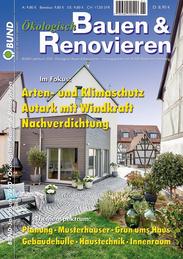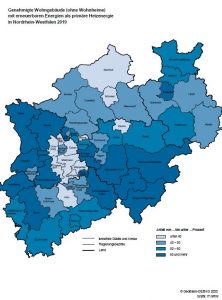More rail transport, reformed motor vehicle tax and less fossil heating needed
 Germany can still achieve its climate targets by 2030. This is shown in a new analysis by the Federal Environment Agency (UBA). This would require, among other things, more rail transport, a reform of the motor vehicle tax and the restriction of fossil heating. In addition, all emissions would have to be priced and charged to the polluter. In the so-called Climate Protection Instruments Scenario 2030 (KIS-2030), the UBA has examined how additional emissions can be saved in the building, mobility, energy and industry sectors. "The model calculation clearly shows that we have a lot of catching up to do in some sectors," says UBA President Dirk Messner. "We now urgently need a constructive dialogue about where emissions can be reduced, otherwise we will miss the legal savings targets. We also need to talk honestly about how to cushion the financial burden on lower-income groups and distribute it more fairly. Currently, low-income households are often asked to pay disproportionately. Understandably, this does not exactly increase acceptance for more climate protection.
Germany can still achieve its climate targets by 2030. This is shown in a new analysis by the Federal Environment Agency (UBA). This would require, among other things, more rail transport, a reform of the motor vehicle tax and the restriction of fossil heating. In addition, all emissions would have to be priced and charged to the polluter. In the so-called Climate Protection Instruments Scenario 2030 (KIS-2030), the UBA has examined how additional emissions can be saved in the building, mobility, energy and industry sectors. "The model calculation clearly shows that we have a lot of catching up to do in some sectors," says UBA President Dirk Messner. "We now urgently need a constructive dialogue about where emissions can be reduced, otherwise we will miss the legal savings targets. We also need to talk honestly about how to cushion the financial burden on lower-income groups and distribute it more fairly. Currently, low-income households are often asked to pay disproportionately. Understandably, this does not exactly increase acceptance for more climate protection.
Kategorie für Blog: Solar thermal
Recommendations from the BMBF project "Urban Heat Transition" were published: ► Consistently tapping alternative heat sources such as wastewater heat ► Convert public buildings to renewable heat and create neighbourhood heating networks ► Ambitious energy refurbishment in neighbourhood conservation areas to keep rents affordable
 The Federal Cabinet today adopted the so-called Easter Package at the proposal of Vice Chancellor and Federal Minister for Economic Affairs and Climate Protection Robert Habeck. This is the largest amendment to energy policy legislation in decades. The Easter Package comprehensively amends various energy laws in order to accelerate and consistently drive forward the expansion of renewable energies.
The Federal Cabinet today adopted the so-called Easter Package at the proposal of Vice Chancellor and Federal Minister for Economic Affairs and Climate Protection Robert Habeck. This is the largest amendment to energy policy legislation in decades. The Easter Package comprehensively amends various energy laws in order to accelerate and consistently drive forward the expansion of renewable energies.
 Fig.: Naturstrom AG
NATURSTROM is expanding its largest local heating project to date in Markt Erlbach, Franconia. In future, the green energy supplier will supply over 130 customers with sustainable and locally generated heat - including households, municipal buildings and a large commercial enterprise. Bavaria's largest solar thermal plant is being built on an area of 2,400 m2 for this purpose.
Fig.: Naturstrom AG
NATURSTROM is expanding its largest local heating project to date in Markt Erlbach, Franconia. In future, the green energy supplier will supply over 130 customers with sustainable and locally generated heat - including households, municipal buildings and a large commercial enterprise. Bavaria's largest solar thermal plant is being built on an area of 2,400 m2 for this purpose.
 Solarserver reports on the world's largest solar heating plant, which has been in operation in China since 2016. It consists of parabolic trough collectors.
On the roof of a XuChen factory building next to the company headquarters are 22,000 m2 collector area, a further 71,000 m2 collector area are implemented as ground-mounted systems. Together they deliver an output of 65 MWth. With concentrating collectors, it would thus be the largest solar heating plant of its kind. An even larger one is the Danish Silkeborg plant (110 MWth)which, however, is equipped with a different collector technology.
For comparison: the largest German solar thermal system that supplies a settlement, neighbourhood or district currently has just 14,800 m²
Solarserver reports on the world's largest solar heating plant, which has been in operation in China since 2016. It consists of parabolic trough collectors.
On the roof of a XuChen factory building next to the company headquarters are 22,000 m2 collector area, a further 71,000 m2 collector area are implemented as ground-mounted systems. Together they deliver an output of 65 MWth. With concentrating collectors, it would thus be the largest solar heating plant of its kind. An even larger one is the Danish Silkeborg plant (110 MWth)which, however, is equipped with a different collector technology.
For comparison: the largest German solar thermal system that supplies a settlement, neighbourhood or district currently has just 14,800 m²
 Environment Minister Franz Untersteller reacted with relief to the agreement reached yesterday by the coalition on the amendment of the Climate Protection Act. The law is to be passed by the state parliament before the summer break and will then replace the previous climate protection law from 2013.
Environment Minister Franz Untersteller reacted with relief to the agreement reached yesterday by the coalition on the amendment of the Climate Protection Act. The law is to be passed by the state parliament before the summer break and will then replace the previous climate protection law from 2013.
 Brussels/Freiburg, 5 May 2020 - An alliance "Solar Europe Now", officially launched on 5 May, is calling for solar energy to be recognised as a key technology for the objectives of the European Green Deal. The new alliance, which currently includes more than 90 players from the entire value chain of the European solar industry, is concerned that the photovoltaic sector is not being given enough consideration in the current presentation of the Green Deal.
Brussels/Freiburg, 5 May 2020 - An alliance "Solar Europe Now", officially launched on 5 May, is calling for solar energy to be recognised as a key technology for the objectives of the European Green Deal. The new alliance, which currently includes more than 90 players from the entire value chain of the European solar industry, is concerned that the photovoltaic sector is not being given enough consideration in the current presentation of the Green Deal.
 From the meeting of the Senate on 10 March 2020:
The Senate today adopted a comprehensive catalogue of measures to accelerate the expansion of solar energy in Berlin, following a proposal by the Senator for Economics, Energy and Public Enterprises, Ramona Pop.
Senator Pop: "The potential study for the Solarcity Masterplan has shown that we can harvest 25 per cent of the electricity generated with solar energy from Berlin's rooftops. We must therefore accelerate the expansion of solar energy in the city. It is necessary for the federal government to finally improve the legal framework for solar energy in cities. Nevertheless, we want to actively utilise the available scope at state level. With the Solarcity Masterplan, we will expand information and advice, provide incentives and also examine regulatory instruments. The implementation of the Solarcity Masterplan is a joint task for the Senate, but also for all Berlin stakeholders from business and society."
From the meeting of the Senate on 10 March 2020:
The Senate today adopted a comprehensive catalogue of measures to accelerate the expansion of solar energy in Berlin, following a proposal by the Senator for Economics, Energy and Public Enterprises, Ramona Pop.
Senator Pop: "The potential study for the Solarcity Masterplan has shown that we can harvest 25 per cent of the electricity generated with solar energy from Berlin's rooftops. We must therefore accelerate the expansion of solar energy in the city. It is necessary for the federal government to finally improve the legal framework for solar energy in cities. Nevertheless, we want to actively utilise the available scope at state level. With the Solarcity Masterplan, we will expand information and advice, provide incentives and also examine regulatory instruments. The implementation of the Solarcity Masterplan is a joint task for the Senate, but also for all Berlin stakeholders from business and society."
 One of the Herculean tasks to achieve the climate targets is to radically reduce CO2 emissions from the heat supply. A group of researchers led by the Institute for Ecological Economy Research (IÖW) shows how cities can turn away from coal, oil and gas in a socially acceptable way. The project "Urban Heat Turnaround" investigated possible contributions from renewable energies and local heat sources in Berlin's urban neighbourhoods. "Waste heat from businesses, heat from waste water or geothermal energy have hardly been used so far.
One of the Herculean tasks to achieve the climate targets is to radically reduce CO2 emissions from the heat supply. A group of researchers led by the Institute for Ecological Economy Research (IÖW) shows how cities can turn away from coal, oil and gas in a socially acceptable way. The project "Urban Heat Turnaround" investigated possible contributions from renewable energies and local heat sources in Berlin's urban neighbourhoods. "Waste heat from businesses, heat from waste water or geothermal energy have hardly been used so far.
Senate adopts concrete measures for the next ten years and sets new CO2-targets for 2030 and 2050
The project, initiated by the Bund für Umwelt und Naturschut The BUND Yearbook Ecological Building & Renovation, published by BUND Deutschland (BUND), helps by making owners fit for discussions with the house bank, architect, energy consultant and craftsmen. The guidebook, which will be available from November, shows what can be done and how: Based on numerous house portraits, the annual compendium helps the reader to find out which measures, building materials and technologies are best suited to their own project.
The BUND Yearbook Ecological Building & Renovation, published by BUND Deutschland (BUND), helps by making owners fit for discussions with the house bank, architect, energy consultant and craftsmen. The guidebook, which will be available from November, shows what can be done and how: Based on numerous house portraits, the annual compendium helps the reader to find out which measures, building materials and technologies are best suited to their own project.
The ecovillage Sieben Linden has existed near Berlin for 30 years. The documentary gives a detailed insight into life there and what the villagers have experienced so far. Available until 28.10.2024
Like the heat register, the solar register is part of the Energy Atlas.NRW, which provides comprehensive information on renewable energies in North Rhine-Westphalia. In addition to the current stock, potential for the further expansion of renewable energies is also presented.
According to the annual balance sheet of the Federal Association of the German Heating Industry (BDH) presented today, the German market for solar thermal systems has shrunk further by 8 percent to 573,500 square meters of collector area.
Yesterday, the Agency for Renewable Energies awarded the Rhine-Hunsrück district as Energy Municipality of the Decade / Environment and Energy Minister Ulrike Höfken congratulates warmly on this award. Yesterday, the Agency for Renewable Energies awarded the Rhine-Hunsrück district in Kassel as "Energy Municipality of the Decade". "Climate change is clearly noticeable in Rhineland-Palatinate, as currently [...]
The state of Rhineland-Palatinate is providing funding of 150,000 euros for a local heating network in Gimbweiler, which is to be supplied in future by means of a solar thermal open-space system and a woodchip system.
The successful implementation of the energy transition requires a variety of technologies that solve different tasks in the energy system. Missing components must be supplemented and optimization processes implemented. Technological innovations, supported by social innovations, play a central role in this. Now, several projects are systematically investigating the potentials of the individual energy technologies and the innovation needs [...]
BN - Is the roof of my house or company building suitable for a photovoltaic system or a solar thermal system? This question can now be answered quickly and conveniently online with the help of the new solar roof cadastre of the city of Bonn. In a building-specific map display, a colored marking indicates whether and to what extent [...]
Future security and climate protection are the most important reasons / High acceptance for plants in the neighbourhood Berlin, 08 August 2017 - The expansion of renewable energies is an important concern for an overwhelming majority of Germans. This is shown by a recent representative survey conducted by Kantar Emnid on behalf of the Renewable Energy Agency [...]
According to Dr. Axel Berg, chairman of the board of the German section of EUROSOLAR, neither ambitious climate protection goals nor increased ecological awareness are the drivers of the energy turnaround, but rather "the exponential cost degression in renewable energy technologies, the technical innovations in storage technologies and a high level of interest from the industrial economy." In his detailed [...]
The ForschungsVerbund Erneuerbare Energien (FVEE) is today publishing its latest conference volume entitled "Research for the energy transition - shaping the energy system". The papers collected here from the last annual conference present current research findings and instruments for a successful energy transition. The spectrum of contributions ranges from scenarios for the transformation of the [...]
Stadtwerke Ludwigsburg-Kornwestheim is building one of the largest solar thermal plants in Germany with a collector area of over 10,000 m². The way is clear for another forward-looking project in Ludwigsburg: Stadtwerke Ludwigsburg-Kornwestheim GmbH (SWLB) has won a prize in the call for funding for municipal climate protection model projects as part of the national climate protection initiative of the Federal Ministry for the Environment, Nature Conservation, Building and Nuclear Safety [...]
The share of renewable energies in total energy consumption in the EU was 16.7 percent in 2015. That is almost twice as much as a decade earlier. Compared with the previous year, the share rose by 0.6 percentage points, the statistics authority Eurostat announced on Tuesday. In 2004, when data first became available, the [...]
In September, Germany's largest thermal solar plant officially went into operation in the Brandenburg city of Senftenberg. The plant was built by Stadtwerke Senftenberg on an area of around 2.2 hectares and is expected to produce around four million kilowatt hours of heat per year.
According to the DGS (Deutsche Gesellschaft für Sonnenenergie e.V. - German Solar Energy Society), the general conditions for solar thermal systems are more attractive than ever before, which is related to the market incentive programme (MAP) for solar thermal subsidies that was overhauled last year. After years of dwindling sales, the latest collector sales statistics from the German Solar Industry Association (BSW) and the German Heating Industry Association [...]
With more than 1,700 completed buildings, SolarActiveHouses are no longer a marginal phenomenon. What has been missing so far is a scientific evaluation of this heat supply concept. To this end, researchers have measured nine solar houses over several heating periods. The responsible project manager Gerhard Stryi-Hipp presented the interim results at the OTTI symposium "Thermal Solar Energy". Read the further in the [...]
Since September 2014, Wagner Solar, a solar pioneer from Cölbe, has been a subsidiary of Sanderink Holding under the leadership of Dutch entrepreneur Gerard Sanderink. The business operations are continued under the name Wagner Solar GmbH. The managing director is Brigitte van Egten, a lawyer with experience in the industry.









